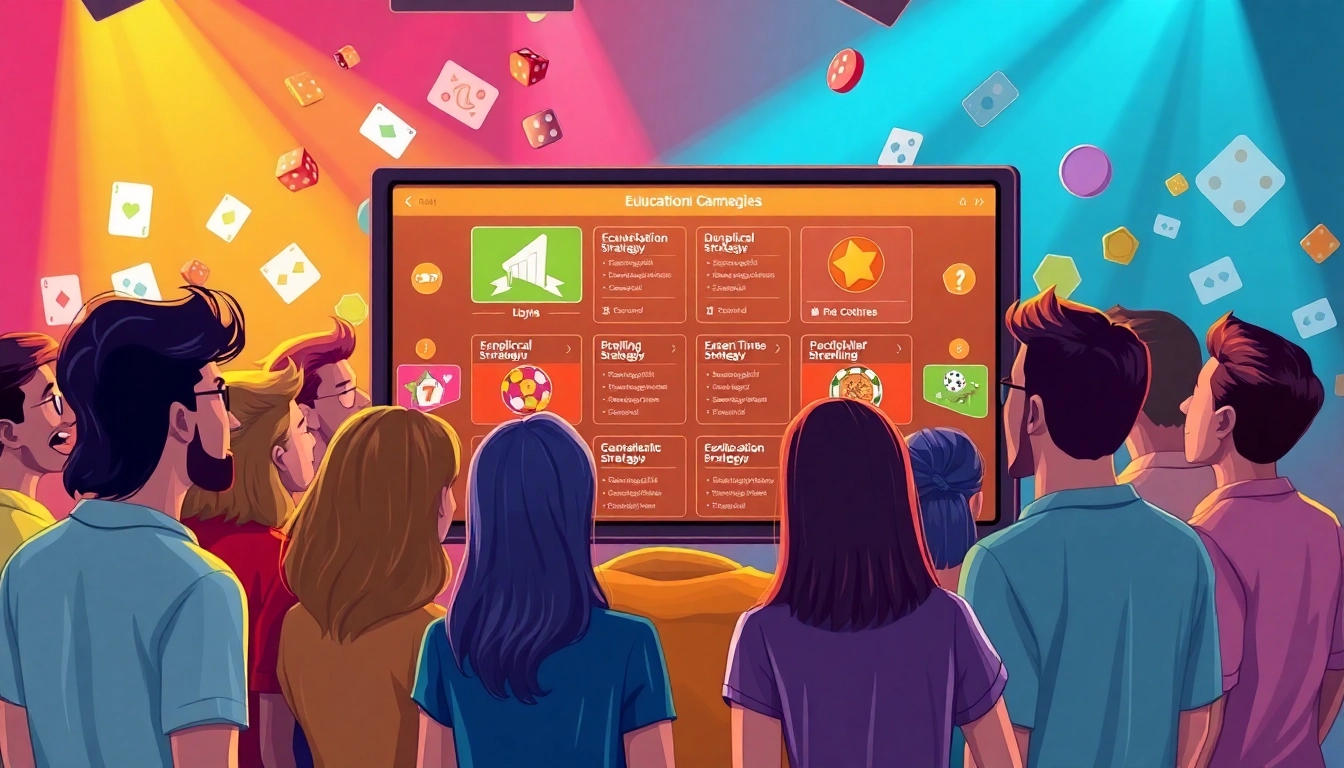Understanding Educational Gamification in Sports Betting
What is Educational Gamification?
Educational gamification refers to the integration of game-like elements into educational content and experiences to enhance user engagement and facilitate learning. This approach employs various techniques from game design, such as points, badges, leaderboards, and challenges, to create a more engaging environment for learners. In the context of sports betting, educational gamification can transform the often daunting process of learning betting strategies into an interactive and enjoyable experience. By incorporating elements of gamification into educational resources, platforms can effectively capture the attention of users and motivate them to explore complex concepts, risk management strategies, and to better understand odds and betting systems. For those interested in implementing gamification in their learning processes, exploring educational gamification can provide numerous insights and tools.
The Role of Gamification in Learning
Gamification plays a crucial role in modern education by fostering engagement and motivation among learners. Traditional educational methods often fall short in captivating the attention of users, especially in fields as complex as sports betting. By introducing game mechanics, educational experiences become more interactive and enjoyable, which can lead to significantly improved learning outcomes.
Moreover, gamified learning encourages healthy competition among peers, promoting social learning that can enhance both understanding and knowledge retention. The incorporation of challenges, rewards, and progress tracking can make the learning process feel less like a chore and more like an adventure, thus fostering a deeper interest in the subject matter. This is especially vital in sports betting, where knowledge of statistics, players, and betting mechanisms can substantially influence outcomes.
Application in Sports Betting
In the world of sports betting, understanding the underlying principles and strategies can make the difference between winning and losing. Educational gamification can be applied in various ways to aid bettors in their learning journey. For example, platforms can create interactive tutorials that simulate betting scenarios, allowing users to practice without real financial risks. The use of virtual currency enables users to place bets, analyze results, and adjust strategies in a safe environment.
Furthermore, gamified quizzes and challenges can help users assess their knowledge of key concepts, such as odds calculation and bet types. This not only reinforces learning but also builds confidence, making users more likely to engage with real betting activities. Ultimately, the application of educational gamification in sports betting can help demystify the process and empower bettors to make informed decisions.
Benefits of Educational Gamification for Gamblers
Enhancing Knowledge Retention
One of the primary advantages of incorporating gamification into educational techniques is the enhancement of knowledge retention. Traditional learning methods may lead to rote memorization rather than genuine understanding, whereas gamified experiences encourage active participation and critical thinking. When users engage with educational content through interactive elements such as quizzes, flashcards, and simulations, the repetition and feedback provided can solidify their knowledge.
For instance, when a user participates in a gamified exercise that teaches them how to analyze betting odds, they are more likely to remember the process because they actively practiced it rather than just reading about it. Recent studies have shown that gamified learning can increase retention rates significantly, making it a valuable tool for those looking to grasp complex betting strategies.
Improving Decision-Making Skills
In the realm of sports betting, the ability to make informed and timely decisions is critical. Educational gamification contributes to honing these decision-making skills by placing users in scenario-based learning environments that simulate real-life betting decisions. When learners encounter situations where they must choose between different wagering options, the need to weigh risks and rewards mirrors the actual betting experience.
This approach not only builds a bettor’s analytical abilities but also enhances their intuitive decision-making skills over time. As users repeatedly engage in these scenarios, they learn to recognize patterns and trends that inform better choices, ultimately resulting in more effective betting strategies.
Increasing User Engagement
User engagement is a fundamental aspect of successful educational platforms, especially in domains like sports betting, where users can quickly become overwhelmed by technical jargon and complex strategies. By implementing gamified elements, platforms can excite users and keep them motivated to learn.
For instance, rewarding users with points for completing educational tasks or achieving milestones can convert learning into a series of enjoyable challenges. Leaderboards and achievements serve as social proof, allowing users to feel a sense of accomplishment compared to their peers, thus driving engagement to new heights. The competitive nature of sports betting naturally aligns with these gamification techniques, encouraging users to participate consistently and explore advanced areas of betting knowledge.
Common Challenges in Implementing Gamification
User Resistance to New Methods
Despite the advantages, implementing gamification can sometimes face resistance from users accustomed to traditional learning methods. Some individuals may hesitate to embrace gamified experiences due to skepticism about their effectiveness or resistance to change. To counteract this, educational platforms should incorporate user feedback regularly and make incremental adjustments to ensure that the gamified content meets the needs and preferences of their audience.
Additionally, offering clear explanations about how the gamification process enhances learning can help foster acceptance. Demonstrating success stories and practical benefits associated with gamified learning experiences may further alleviate concerns and encourage participation.
Balancing Fun and Education
A critical challenge in gamifying educational content is striking the right balance between fun and educational value. While engaging gameplay mechanics can make learning more enjoyable, they must not compromise the core educational objectives. Overemphasizing the game’s entertainment aspects might lead users to focus on the gaming experience rather than genuine learning.
To overcome this challenge, developers should thoughtfully design gamified experiences that reinforce educational goals while ensuring that game mechanics enhance rather than distract from the learning process. Interactive elements should help illustrate complex concepts, making them more accessible while preserving the educational integrity of the content.
Measuring Effectiveness
Finally, measuring the effectiveness of educational gamification strategies poses another challenge for platforms. Identifying key performance indicators (KPIs) that accurately reflect user engagement, retention, and knowledge acquisition can be complex. Without appropriate metrics, platforms may struggle to gauge the success of their gamified educational offerings and make necessary adjustments.
To tackle this issue, platforms should establish clear objectives prior to implementing gamified elements, using both qualitative and quantitative data to assess performance. Implementing analytics tools to track user behavior can provide valuable insights into engagement levels, while feedback surveys can capture user satisfaction and areas for improvement. By continuously analyzing these metrics, platforms can refine their gamified experiences to better serve the learning needs of bettors.
Best Practices for Creating Gamified Learning Experiences
Designing Interactive Content
The cornerstone of successful educational gamification lies in creating interactive content that captivates and engages users. Leveraging technology to incorporate animations, simulations, and engaging visuals can substantially enhance the user experience. Interactive quizzes, where users receive immediate feedback on their answers, can provide both motivation and valuable learning opportunities.
Moreover, incorporating storytelling elements into gamified experiences can make learning more relatable and enjoyable. A narrative framework allows users to immerse themselves in a learning journey that feels organic and personal, enhancing their connection to the content.
Incorporating Feedback Loops
Establishing feedback loops is vital in gamification, as they provide users with timely responses to their actions. Feedback serves as a critical guide, allowing learners to understand their progress and adjust their strategies accordingly. In sports betting, instant feedback on correct or incorrect decisions can help users refine their decision-making approach, deepening their understanding of betting concepts.
Implementing timely rewards for achieving milestones or completing challenges can further enhance motivation. Acknowledging user progress through notifications or badges fosters a sense of accomplishment and encourages continued engagement with educational material.
Utilizing Tiered Learning Approaches
To cater to users with diverse levels of expertise, employing tiered learning approaches is essential. Allowing users to progress through levels based on their competencies can promote a sense of achievement while ensuring that both novices and experienced gamblers derive value from the educational content.
Platforms should design a clear path for progression, where users can unlock more complex concepts and strategies as they demonstrate mastery of foundational topics. This structured approach not only reinforces knowledge retention but also caters to users’ needs, making the learning experience more satisfying and effective.
Case Studies: Successful Examples of Educational Gamification
Case Study 1: A Leading Betting Platform
A notable example of successful educational gamification can be seen in a leading online betting platform that implemented a comprehensive gamified training program. The platform designed an interactive learning pathway where users could engage in simulated betting scenarios, complete educational modules, and compete on leaderboards. This initiative led to a significant increase in user knowledge, engagement, and overall betting confidence.
The platform utilized analytics to track user progress and adapt challenges to individual learning styles, which helped sustain user interest over time. Feedback loops kept users informed about their performance, ultimately leading to a remarkable reduction in beginner betting mistakes, boosting overall success rates.
Case Study 2: Innovative Gambling Education Apps
Another success story lies with a dedicated gambling education app that employed gamification techniques to teach users about responsible gambling and betting strategies. The app incorporated elements such as mini-games, quizzes, and social components that connected users with peers. This gamified approach improved learning outcomes while also fostering a community around shared educational goals.
User feedback indicated a higher level of satisfaction with the gamified learning approach compared to traditional resources, underscoring the effectiveness of interactive education in enhancing knowledge retention and engagement.
Case Study 3: Community-Based Learning Platforms
A community-driven learning platform for sports betting created a gamified environment that encouraged users to interact with educational content collaboratively. Features like discussion forums, collaborative projects, and group challenges transformed the learning experience into a social endeavor, attracting users from various backgrounds.
By harnessing group dynamics and promoting peer-to-peer learning, this platform not only improved knowledge retention but also created networks of support that helped users navigate the complexities of sports betting. The collaborative approach proved highly beneficial, demonstrating how community engagement amplified the effects of educational gamification.



